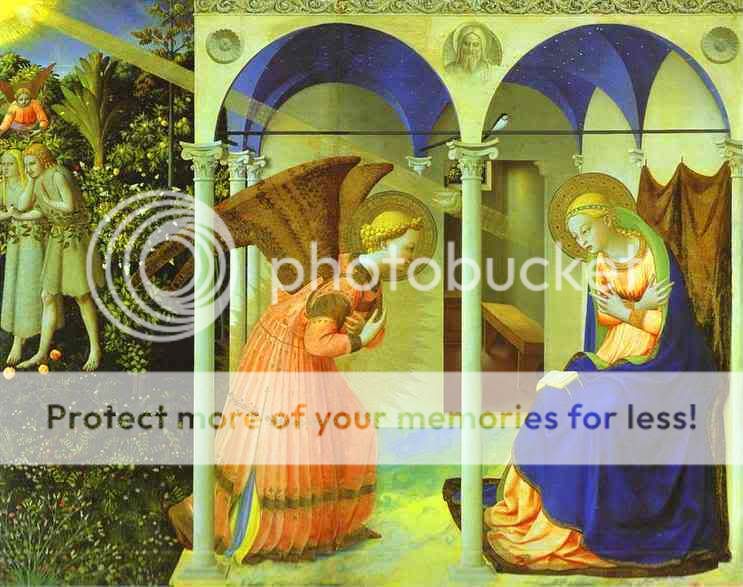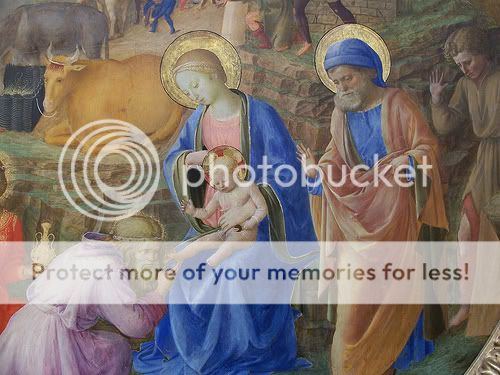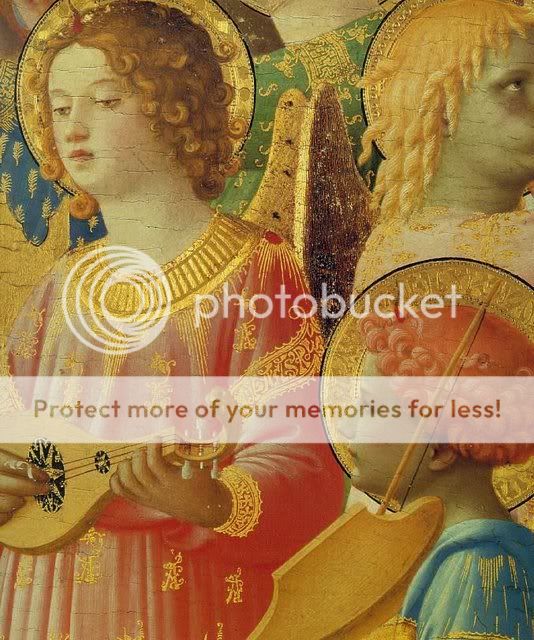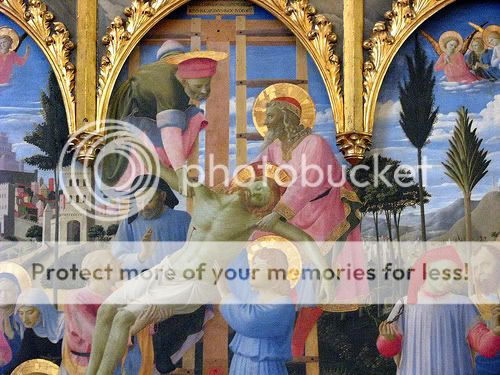Art Sunday 06/08/08: Fra Angelico
Coronation of the Virgin
Fra Angelico
The Louvre, Paris
I discovered the work of Fra Angelico for myself. What I love about his paintings are his choice of colors. I love the blue and peachy shades he uses in his paintings. Most Renaissance paintings have mostly reds and golds, but I love Angelico’s soothing blue shades in his work, and they seem to be in many of his paintings. I love Renaissance art and I find it to be a refreshing way of seeing it. Enjoy them !
Fra Angelico was an Italian painter of the early Renaissance who combined the life of a devout friar with that of an accomplished painter. He was called Angelico (Italian for “angelic”) and Beato (Italian for “blessed”) because the paintings he did were of calm, religious subjects and because of his extraordinary personal piety.

Annunciation
In Fiesole
Originally named Guido di Pietro, Angelico was born in Vicchio, Tuscany. He entered a Dominican convent in Fiesole in 1418 and about 1425 became a friar using the name Giovanni da Fiesole. Although his teacher is unknown, he apparently began his career as an illuminator of missals and other religious books. He began to paint altarpieces and other panels; among his important early works are the Madonna of the Star (1428?-1433, San Marco, Florence) and Christ in Glory Surrounded by Saints and Angels (National Gallery, London), which depicts more than 250 distinct figures. Among other works of that period are two of the Coronation of the Virgin (San Marco and Louvre, Paris) and The Deposition and The Last Judgment (San Marco). His mature style is first seen in the Madonna of the Linen Weavers (1433, San Marco), which features a border with 12 music-making angels.

Adoration of the Magi
In Florence and Rome
In 1436 the Dominicans of Fiesole moved to the convent of San Marco in Florence, which had recently been rebuilt by Michelozzo. Angelico, sometimes aided by assistants, painted many frescoes for the cloister, chapter house, and entrances to the 20 cells on the upper corridors. The most impressive of these are The Crucifixion, Christ as a Pilgrim, and Transfiguration. His altarpiece for San Marco (1439?) is one of the first representations of what is known as a Sacred Conversation: the Madonna flanked by angels and saints who seem to share a common space. In 1445 Angelico was summoned to Rome by Pope Eugenius IV to paint frescoes for the now destroyed Chapel of the Sacrament in the Vatican. In 1447, with his pupil Benozzo Gozzoli, he painted frescoes for the cathedral in Orvieto. His last important works, frescoes for the chapel of Pope Nicholas in the Vatican, are Scenes from the Lives of Saints Stephen and Lawrence (1447-1449), probably painted from his designs by assistants.

Angels
From 1449 to 1452 Angelico was prior of his convent in Fiesole. He died in the Dominican convent in Rome on March 18, 1455.
Angelico combined the influence of the elegantly decorative Gothic style of Gentile da Fabriano with the more realistic style of such Renaissance masters as the painter Masaccio and the sculptors Donatello and Ghiberti, all of whom worked in Florence. Angelico was also aware of the theories of perspective proposed by Leon Battista Alberti. Angelico’s representation of devout facial expressions and his use of color to heighten emotion are particularly effective. His skill in creating monumental figures, representing motion, and suggesting deep space through the use of linear perspective, especially in the Roman frescoes, mark him as one of the foremost painters of the Renaissance.

The Disposition of the Cross
|
lauritasita wrote on Jun 7, ’08
Yeah, I love the halos, too! I especially love his blues.
|
|
sanssouciblogs wrote on Jun 7, ’08
The blues glow, aren’t they gorgeous. The work almost looks back lit. Just magnificent. Now you know why we used to go to Italy so much–to see works like this in person.
|
|
lauritasita wrote on Jun 7, ’08
I find this a fresh way of viewing Renaissance art. I’ll have to try that Fra Angelico liqueur. It sounds good !
|
|
vickiecollins wrote on Jun 7, ’08
Lauritasita, I certainly see why you like this painter. I love vivid bright colors as well.
Good choice. |
|
lauritasita wrote on Jun 7, ’08
Thank you for your comment, vickie. I love colorful art, too. I think it has a healing sort of quality.
|
|
philsgal7759 wrote on Jun 7, ’08, edited on Jun 7, ’08
I have always enjoyed this artist. The only one of these I don’t love is The Disposition of the Cross for the reason I loved the others Somehow light airy colors do not fit the mood of removing the body from the cross.Sort of like wearing a party dress to a funeral it just doesn’t feel right. But maybe it is me. I just see the other events he painted as celebrations and those colors work well. Whereas I think it might have been interesting had he chosen dark or muted shades I wonder if it might have made the painting even better.
|
|
lauritasita wrote on Jun 7, ’08, edited on Jun 7, ’08
Narice, you’ve made a very interesting point about the last painting: even though the colors are beautiful, the mood of the painting is sad. Though I wouldn’t necessarily call these colors cheerful. Blue has been associated with royalty and importance. Maybe that’s why those colors were chosen.
|
|
wickedlyinnocent wrote on Jun 7, ’08
Fra Angelico is about light, early Renaissance artists didn’t master dark colours, all the gold and blue and pink in his works are absolutely beautiful, the Annunciation is one of the loveliest ever, with the expulsion from Paradise ; and look at those angels, he must have started as an illuminator.His influence stretched to Ghirlandaio and even Michelangelo. I think your blog fits into this week’s theme, you can’t have darkness if you don’t have the light too. Thanks for participating, good night.
|
|
strongwilledwoman wrote on Jun 7, ’08
Beautiful presentation.
|
|
lauritasita wrote on Jun 7, ’08
Thanks, Bev ! I’m glad you enjoy it !
|
|
millimusings wrote on Jun 8, ’08
What a superb artist and you are correct the colours a gorgeous. He certainly was a perfectionist and his work i would describe as being Divine in more ways than one. Your background theme really suits this artwork beautifully. Well done.
|
|
lauritasita wrote on Jun 8, ’08
Thank you for your comment, milli. When I first found “Coronation of the Virgin”, I just had to do a post on this artist. This is the first time I saw his work. I love it!
|
|
forgetmenot525 wrote on Jun 8, ’08
they are indeed beautiful paintings, and the music here compliments the art work so well, perfect choice
http://forgetmenot525.multiply.com/journal/item/38/ART_SUNDAY_DARK_ART |
|
lauritasita wrote on Jun 8, ’08
Thank you for your kind comment, forgetmenot ! I love the background music, too !
|
|
dangerousmeredith wrote on Jun 8, ’08
thanks for all this interesting info. such delicate and lovely paintings
|
|
lauritasita wrote on Jun 9, ’08
Hi dangerousmeredith ! Thanks so much for your comment.
|


Comments
Art Sunday 06/08/08: Fra Angelico — No Comments
HTML tags allowed in your comment: <a href="" title=""> <abbr title=""> <acronym title=""> <b> <blockquote cite=""> <cite> <code> <del datetime=""> <em> <i> <q cite=""> <s> <strike> <strong>